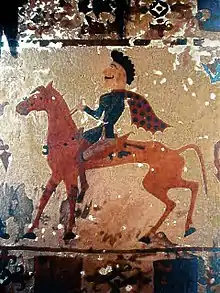Gogok
Gobeunok or Gogok are comma-shaped or curved beads and jewels that appeared from prehistoric Korea through the Three Kingdoms of Korea.
| Gogok | |
 Glass and jade beads excavated from the Tomb of King Muryeong with gold cap ornaments. | |
| Korean name | |
|---|---|
| Hangul | 곱은옥 or 곡옥 |
| Hanja | 곱은玉 or 曲玉 |
| Revised Romanization | gobeunok or gogok |
| McCune–Reischauer | kobǔnok or kokok |
Details
Gogok is also sometimes romanized as "kog-ok" and "kokk-ok" or "kok-ok." They are also found in Northeast Asia, but are most numerous in Japan (Magatama) and especially in Hokkaido from Jōmon period populations. Although usually made from jadeite mined in Japan, they have been discovered made from many different materials such as nephrite, stone, clay, bone and glass. They range in size range from 1 to 10 centimetres (0.39 to 3.94 in), and have a small hole in the middle of the round part for threading. They were used as earrings and necklaces, and as decoration on crowns, belts, and bracelets. Some are further decorated with gold or silver attachments.
The curved nature of the gogok beads and their similarities to bear claws has led to a theory of Scytho-Iranian and Persian influence and origin created by bear totem tribes.[1][2]
In Korea, jade gogok are found at prehistoric sites.[3] Throughout the Korean Peninsula, nephrite gogok are found inland Bronze Age sites in stone burial chambers (stone cists and dolmens). This probably indicates that gogok were symbols of prestige and power buried with the elites of society.
The most famous examples of gogok in Korean art are from the Three Kingdoms period, in the crowns of Silla, earrings, necklaces, and royal girdle of Korea. These treasures were found in the burial mounds and royal mausoleums of Silla, Baekje, and Gaya confederacy.[4] The ornamental antlers and tree-like structures of the Silla crown and similarities of the crown with works from the Eurasian Steppe and Afghanistan suggests vast networks of trade and also reinforces a Scytho-Iranian origin for gogok.[5] They declined in use from about the middle of the 6th century.[6]

Notes
- http://www.metmuseum.org/explore/publications/pdfs/korea/divided/Materials-Music.pdf#search='comma%20shaped%20silla%20beads'
- "1,500 Years of Contact between Korea and the Middle East". Middle East Institute. Retrieved 2017-04-13.
- magatama - Britannica Online Encyclopedia
- The Fitzwilliam Museum : Catalogue Introduction Archived 2011-06-12 at the Wayback Machine
- Korea, 1–500 A.D. | Timeline of Art History | The Metropolitan Museum of Art
- 야후! 백과사전 - 곡옥
References
- Korea Britannica article (in Korean)
- Doosan World Encyclopedia article (in Korean)
- Yahoo Korea Encyclopedia (in Korean)
